Egerton Hall, Manchester [1] was founded as a Theological College in 1908 [2] to train Anglican clergy to serve in the Church of England.It was located in Oxford Place [3] and closed in 1944. [4]
Egerton Hall, Manchester [1] was founded as a Theological College in 1908 [2] to train Anglican clergy to serve in the Church of England.It was located in Oxford Place [3] and closed in 1944. [4]
53°16′26″N2°07′52″W / 53.274°N 2.131°W

Wilmslow Road is a major road in Manchester, England, running from Parrs Wood northwards to Rusholme where it becomes the Oxford Road. The name of the road changes again to Oxford Street when it crosses the River Medlock before reaching Manchester city centre.

King Street is one of the most important thoroughfares of Manchester city centre, England. For much of the 20th century it was the centre of the north-west banking industry but it has become progressively dominated by upmarket retail instead of large banks.

Sunlight House is a Grade II listed building in the Art Deco style on Quay Street in Manchester, England. Completed in 1932 for Joseph Sunlight, at 14 storeys it was the tallest building in Manchester, and the top floors of turrets and multiple dormer windows and mansard roofs create a distinctive skyline.
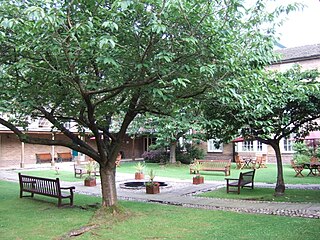
Unitarian College Manchester is one of two Unitarian seminaries in England. It is based at Luther King House in the Brighton Grove area of Manchester, and its degrees are validated by the University of Manchester.

Heald Green railway station serves the suburb of Heald Green in Stockport, Greater Manchester, England.

Gatley railway station is on the Styal Line in Greater Manchester, England. It serves the village of Gatley in the Metropolitan Borough of Stockport.

Printworks is an urban entertainment venue offering a cinema, clubs and eateries, located on the corner of Withy Grove and Corporation Street in Manchester city centre, England.

St. Elisabeth's Church is an Anglo Catholic church in Reddish, an area in the Metropolitan Borough of Stockport, Greater Manchester, England, designed by Alfred Waterhouse in the Victorian Gothic style. It is a grade I listed building.

Warrington Arpley railway station was a station located on the south side of Wilson Patten Street, Warrington, England at the junction of St Helens Railway and Warrington and Stockport Railway. It opened on 1 May 1854; and it closed to passengers on 5 September 1958. Both railways were absorbed by the LNWR. The station was on the southmost Liverpool to Manchester line.

The Mechanics' Institute, located at 103 Princess Street, Manchester, England, is notable as the building in which three significant British institutions were founded: the Trades Union Congress (TUC), the Co-operative Insurance Society (CIS) and the University of Manchester Institute of Science and Technology (UMIST). In the 1960s it was occupied by the Manchester College of Commerce. It has been a Grade II* listed building since 10 May 1972.

Lancaster House in Whitworth Street, Manchester, England, is a former packing and shipping warehouse built between 1905 and 1910 for Lloyd's Packing Warehouses Limited, which had, by merger, become the dominant commercial packing company in early 20th century Manchester. It is in the favoured Edwardian Baroque style and constructed with a steel frame clad with granite at the base and Accrington red brick and orange terracotta. The back of the building is plain red brick. It is a Grade II* listed building as of 2 October 1974.
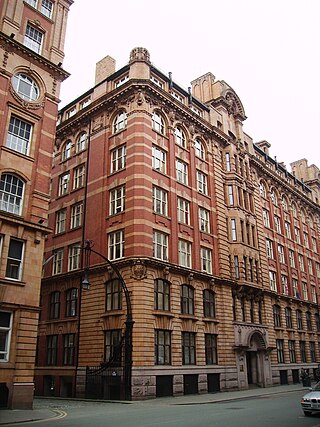
India House in Whitworth Street, Manchester, England, is a packing and shipping warehouse built in 1906 for Lloyd's Packing Warehouses Limited, which had, by merger, become the dominant commercial packing company in early-20th century Manchester. It is in the favoured Edwardian Baroque style and is steel-framed, with cladding of buff terracotta and red brick with buff terracotta dressings. It is a Grade II* listed building as of 2 October 1974.

The Tootal, Broadhurst and Lee Building at No. 56 Oxford Street, in Manchester, England, is a late Victorian warehouse and office block built in a neo-Baroque style for Tootal Broadhurst Lee, a firm of textile manufacturers.

Grove House, on Oxford Road, Chorlton-on-Medlock, Manchester, England, is an early Victorian building, originally three houses, of 1838–40. It is a Grade II* listed building as of 18 December 1963.
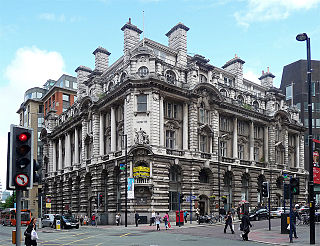
53 King Street is an Edwardian Baroque bank on King Street in Manchester, England. Designed by architect Charles Heathcote, it opened in 1913 and was granted Grade II listed building status in 1974. It used to house a branch of Lloyds TSB. In 2009, the building was sold for £6 million. The building stands on the site of the old Manchester Town Hall.
Piccadilly Mill, also known as Bank Top Mill or Drinkwater's Mill, owned by Peter Drinkwater, was the first cotton mill in Manchester, England, to be directly powered by a steam engine, and the 10th such mill in the world. Construction of the four-storey mill on Auburn Street started in 1789 and its 8 hp Boulton and Watt engine was installed and working by 1 May 1790. Initially the engine drove only the preparatory equipment and spinning was done manually. The mill-wright was Thomas Lowe, who had worked for William Fairbairn and helped with the planning two of Arkwright's earliest factories.

The Shakespeare is a Grade II listed public house at 1 Glynne Street, Farnworth, Greater Manchester BL4 7DN.

Victoria Mill is a Grade II* listed 19th-century cotton spinning mill in Miles Platting, Manchester, England. It was a double mill designed by George Woodhouse and completed in 1869.
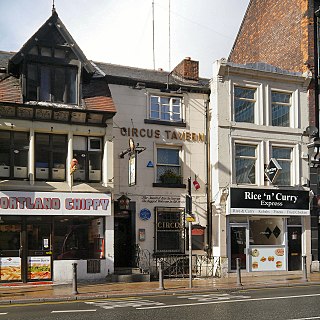
The Circus Tavern in Portland Street, Manchester, England, is the smallest public house in the city, with one of the smallest bars in the country. Built in about 1790, it is also one of the oldest pubs in Manchester, although it only became a pub in about 1840. The pub is owned by Tetley's, a Yorkshire brewery, and contains photographs of former Manchester United players who frequented the pub, including George Best. It was listed as a Grade II building in 1994.
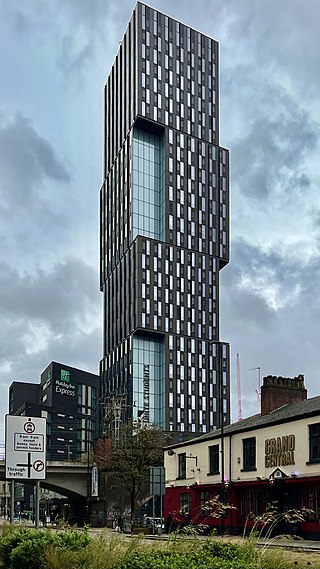
Artisan Heights, also known as 1-5 Wakefield Street, is a student accommodation high-rise tower in Manchester, England. The 95 m (312 ft) tall building was designed by SimpsonHaugh & Partners and contains 603 student bedrooms. As of 2023, it is the 20th-tallest building in Greater Manchester.